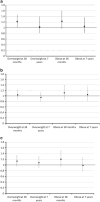Infant antibiotic exposures and early-life body mass
- PMID: 22907693
- PMCID: PMC3798029
- DOI: 10.1038/ijo.2012.132
Infant antibiotic exposures and early-life body mass
Abstract
Objectives: To examine the associations of antibiotic exposures during the first 2 years of life and the development of body mass over the first 7 years of life.
Design: Longitudinal birth cohort study.
Subjects: A total of 11 532 children born at 2500 g in the Avon Longitudinal Study of Parents and Children (ALSPAC), a population-based study of children born in Avon, UK in 1991-1992.
Measurements: Exposures to antibiotics during three different early-life time windows (<6 months, 6-14 months, 15-23 months), and indices of body mass at five time points (6 weeks, 10 months, 20 months, 38 months and 7 years).
Results: Antibiotic exposure during the earliest time window (<6 months) was consistently associated with increased body mass (+0.105 and +0.083 s.d. unit, increase in weight-for-length Z-scores at 10 and 20 months, P<0.001 and P=0.001, respectively; body mass index (BMI) Z-score at 38 months +0.067 s.d. units, P=0.009; overweight OR 1.22 at 38 months, P=0.029) in multivariable, mixed-effect models controlling for known social and behavioral obesity risk factors. Exposure from 6 to 14 months showed no association with body mass, while exposure from 15 to 23 months was significantly associated with increased BMI Z-score at 7 years (+0.049 s.d. units, P=0.050). Exposures to non-antibiotic medications were not associated with body mass.
Conclusions: Exposure to antibiotics during the first 6 months of life is associated with consistent increases in body mass from 10 to 38 months. Exposures later in infancy (6-14 months, 15-23 months) are not consistently associated with increased body mass. Although effects of early exposures are modest at the individual level, they could have substantial consequences for population health. Given the prevalence of antibiotic exposures in infants, and in light of the growing concerns about childhood obesity, further studies are needed to isolate effects and define life-course implications for body mass and cardiovascular risks.
Conflict of interest statement
The authors declare no conflict of interest.
Figures


Comment in
-
Gut microbiota: adding weight to the microbiota's role in obesity--exposure to antibiotics early in life can lead to increased adiposity.Nat Rev Endocrinol. 2012 Nov;8(11):623. doi: 10.1038/nrendo.2012.173. Epub 2012 Sep 11. Nat Rev Endocrinol. 2012. PMID: 22965166 No abstract available.
-
Gut microbiota: Adding weight to the microbiota's role in obesity--exposure to antibiotics early in life can lead to increased adiposity.Nat Rev Gastroenterol Hepatol. 2012 Nov;9(11):615. doi: 10.1038/nrgastro.2012.175. Epub 2012 Sep 11. Nat Rev Gastroenterol Hepatol. 2012. PMID: 22965425 No abstract available.
References
-
- Jayachandran S, Lleras-Muney A, Smith KV. Modern Medicine and the 20th Century Decline in Mortality: Evidence on the Impact of Sulfa Drugs. The National Bureau of Economic Research; 2009. (NBER Working Paper Series No 15089).
-
- McCaig LF, Besser RE, Hughes JM. Trends in antimicrobial prescribing rates for children and adolescents. JAMA. 2002;287:3096–3102. - PubMed
-
- Finkelstein JA, Metlay JP, Davis RL, Rifas-Shiman SL, Dowell SF, Platt R. Antimicrobial use in defined populations of infants and young children. Arch Pediatr Adolesc Med. 2000;154:395–400. - PubMed
-
- Hicks LA, Chien YW, Taylor TH, Jr, Haber M, Klugman KP. Outpatient antibiotic prescribing and nonsusceptible Streptococcus pneumoniae in the United States, 1996–2003. Clin Infect Dis. 2011;53:631–639. - PubMed
-
- Paul IM, Maselli JH, Hersh AL, Boushey HA, Nielson DW, Cabana MD. Antibiotic prescribing during pediatric ambulatory care visits for asthma. Pediatrics. 2011;127:1014–1021. - PubMed
Publication types
MeSH terms
Substances
Grants and funding
LinkOut - more resources
Full Text Sources
Other Literature Sources
Medical

